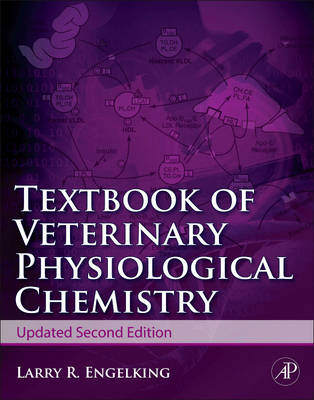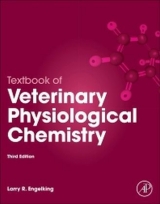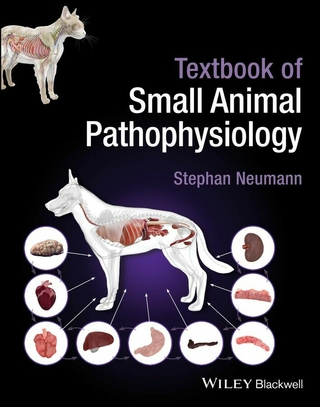
Textbook of Veterinary Physiological Chemistry, Updated 2/e
Academic Press Inc (Verlag)
978-0-12-384852-9 (ISBN)
- Titel erscheint in neuer Auflage
- Artikel merken
Written in a succinct style with each chapter including an overview summary section, numerous illustrations for best comprehension, and end of the chapter questions to assess understanding, The Textbook of Veterinary Physiological Chemistry offers broad coverage of biochemical principles for students studying veterinary medicine. Since first year students come into programs with different scientific backgrounds, this text offers students foundational concepts in physiological chemistry and offers numerous opportunities for practice. Bridging the gap between science and clinical application of concepts, this textbook covers cellular level concepts related to the biochemical processes in the entire animal in a student-friendly, approachable manner.
KEY FEATURES
Updated four color interior design
Coverage of cellular level concepts related to biochemical processes in entire animal
Written in a succint manner for quick comprehension
Larry Engelking holds B.S. and M.S. degrees in biology from Idaho State University, and a Ph.D. degree in physiology from Kansas State University. He has held post-doctoral research positions at the University of Florida Veterinary School and the University of Alabama Medical School, teaching positions at Harvard University, and professorial positions at Tufts University. With over 35 years of teaching and research experience, Dr. Engelking is an expert in the fields of biochemistry and physiology.
Section I: Amino Acid and Protein Metabolism
1 Chemical Composition of Living Cells
2 Properties of Amino Acids
3 Amino Acid Modifications
4 Protein Structure
5 Properties of Enzymes
6 Enzyme Kinetics
7 Protein Digestion
8 Amino Acid Catabolism
9 Transamination and Deamination Reactions
10 Urea Cycle (Krebs-Henseleit Ornithine Cycle)
11 Glutamine and Ammonia
12 Nonprotein Derivatives of Amino Acids
Section II: Nucleotide and Nucleic Acid Metabolism
13 Nucleotides
14 Pyrimidine Biosynthesis
15 Purine Biosynthesis
16 Folic Acid
17 Nucleic Acid and Nucleotide Turnover
Section III: Carbohydrate and Heme Metabolism
18 Carbohydrate Structure
19 Polysaccharides and Carbohydrate Derivatives
20 Glycoproteins and Glycolipids
21 Overview of Carbohydrate Metabolism
22 Glucose Trapping
23 Glycogen
24 Introduction to Glycolysis (The Embden-Meyerhoff Pathway (EMP)
25 Initial Reactions in Anaerobic Glycolysis
26 Intermediate Reactions in Anaerobic Glycolysis
27 Metabolic Fates of Pyruvate
28 Hexose Monophosphate Shunt (HMS)
29 Uronic Acid Pathway
30 Erythrocytic Protection from O2 Toxicity
31 Carbohydrate Metabolism in Erythrocytes
32 Heme Biosynthesis
33 Heme Degradation
34 Tricarboxylic Acid (TCA) Cycle
35 Leaks in the Tricarboxylic Acid (TCA) Cycle
36 Oxidative Phosphorylation
37 Gluconeogenesis
38 Carbohydrate Digestion
Section IV: Vitamins and Trace Elements
39 Vitamin C
40 Thiamin (B1) and Riboflavin (B2)
41 Niacin (B3) and Pantothenic Acid (B5)
42 Biotin and Pyridoxine (B6)
43 Cobalamin (B12)
44 Vitamin A
45 Vitamin D
46 Vitamin E
47 Vitamin K
48 Iron
49 Zinc
50 Copper
51 Manganese and Selenium
52 Iodine and Cobalt
Section V: Lipid Metabolism
53 Overview of Lipid Metabolism
54 Saturated and Unsaturated Fatty Acids
55 Fatty Acid Oxidation
56 Fatty Acid Biosynthesis
57 Triglycerides and Glycerophospholipids
58 Phospholipid Degradation
59 Sphingolipids
60 Lipid Digestion
61 Cholesterol
62 Bile Acids
63 Lipoprotein Complexes
64 Chylomicrons
65 VLDL, IDL, and LDL
66 LDL Receptors and HDL
67 Hyperlipidemias
68 Eicosanoids I
69 Eicosanoids II
70 Lipolysis
71 Ketone Body Formation and Utilization
72 Fatty Liver Syndrome (Steatosis)
Section VI: Intermediary Metabolism
73 Starvation (Transition into the Postabsorptive Stage)
74 Starvation (The Early Phase)
75 Starvation (The Intermediate Phase)
76 Starvation (The Late Phase)
77 Exercise (Circulatory Adjustments and Creatine)
78 Exercise (O2(max) and RQ)
79 Exercise (Substrate Utilization and Endocrine Parameters)
80 Exercise (Muscle Fiber Types and Characteristics)
81 Exercise (Athletic Animals)
Section VII: Acid-Base Balance
82 Hydrogen Ion Concentration
83 Strong and Weak Electrolytes
84 Protein Buffer Systems
85 Bicarbonate, Phosphate, and Ammonia Buffer Systems
86 Anion Gap
87 Metabolic Acidosis
88 Diabetes Mellitus (Metabolic Acidosis and Potassium Balance)
89 Metabolic Alkalosis
90 Respiratory Acidosis
91 Respiratory Alkalosis.
92 Strong Ion Difference (SID)
93 Alkalinizing and Acidifying Solutions
94 Dehydration/Overhydration
Appendix
References
Index
| Verlagsort | San Diego |
|---|---|
| Sprache | englisch |
| Maße | 216 x 276 mm |
| Gewicht | 1740 g |
| Themenwelt | Veterinärmedizin ► Vorklinik ► Physiologie |
| ISBN-10 | 0-12-384852-0 / 0123848520 |
| ISBN-13 | 978-0-12-384852-9 / 9780123848529 |
| Zustand | Neuware |
| Haben Sie eine Frage zum Produkt? |
aus dem Bereich



